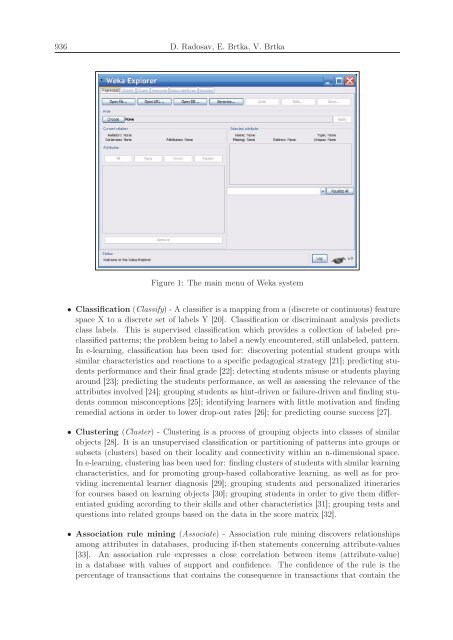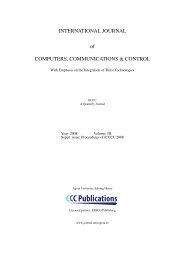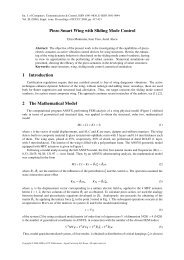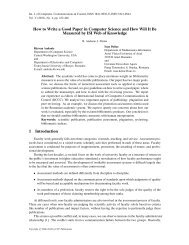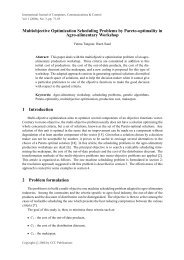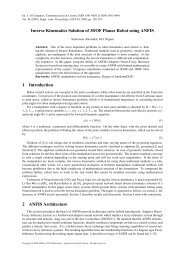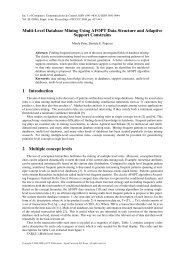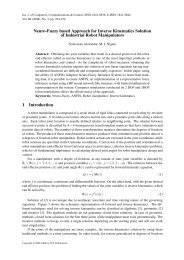Mining Association Rules from Empirical Data in the Domain of ...
Mining Association Rules from Empirical Data in the Domain of ...
Mining Association Rules from Empirical Data in the Domain of ...
You also want an ePaper? Increase the reach of your titles
YUMPU automatically turns print PDFs into web optimized ePapers that Google loves.
936 D. Radosav, E. Brtka, V. Brtka<br />
Figure 1: The ma<strong>in</strong> menu <strong>of</strong> Weka system<br />
• Classification (Classify) - A classifier is a mapp<strong>in</strong>g <strong>from</strong> a (discrete or cont<strong>in</strong>uous) feature<br />
space X to a discrete set <strong>of</strong> labels Y [20]. Classification or discrim<strong>in</strong>ant analysis predicts<br />
class labels. This is supervised classification which provides a collection <strong>of</strong> labeled preclassified<br />
patterns; <strong>the</strong> problem be<strong>in</strong>g to label a newly encountered, still unlabeled, pattern.<br />
In e-learn<strong>in</strong>g, classification has been used for: discover<strong>in</strong>g potential student groups with<br />
similar characteristics and reactions to a specific pedagogical strategy [21]; predict<strong>in</strong>g students<br />
performance and <strong>the</strong>ir f<strong>in</strong>al grade [22]; detect<strong>in</strong>g students misuse or students play<strong>in</strong>g<br />
around [23]; predict<strong>in</strong>g <strong>the</strong> students performance, as well as assess<strong>in</strong>g <strong>the</strong> relevance <strong>of</strong> <strong>the</strong><br />
attributes <strong>in</strong>volved [24]; group<strong>in</strong>g students as h<strong>in</strong>t-driven or failure-driven and f<strong>in</strong>d<strong>in</strong>g students<br />
common misconceptions [25]; identify<strong>in</strong>g learners with little motivation and f<strong>in</strong>d<strong>in</strong>g<br />
remedial actions <strong>in</strong> order to lower drop-out rates [26]; for predict<strong>in</strong>g course success [27].<br />
• Cluster<strong>in</strong>g (Cluster) - Cluster<strong>in</strong>g is a process <strong>of</strong> group<strong>in</strong>g objects <strong>in</strong>to classes <strong>of</strong> similar<br />
objects [28]. It is an unsupervised classification or partition<strong>in</strong>g <strong>of</strong> patterns <strong>in</strong>to groups or<br />
subsets (clusters) based on <strong>the</strong>ir locality and connectivity with<strong>in</strong> an n-dimensional space.<br />
In e-learn<strong>in</strong>g, cluster<strong>in</strong>g has been used for: f<strong>in</strong>d<strong>in</strong>g clusters <strong>of</strong> students with similar learn<strong>in</strong>g<br />
characteristics, and for promot<strong>in</strong>g group-based collaborative learn<strong>in</strong>g, as well as for provid<strong>in</strong>g<br />
<strong>in</strong>cremental learner diagnosis [29]; group<strong>in</strong>g students and personalized it<strong>in</strong>eraries<br />
for courses based on learn<strong>in</strong>g objects [30]; group<strong>in</strong>g students <strong>in</strong> order to give <strong>the</strong>m differentiated<br />
guid<strong>in</strong>g accord<strong>in</strong>g to <strong>the</strong>ir skills and o<strong>the</strong>r characteristics [31]; group<strong>in</strong>g tests and<br />
questions <strong>in</strong>to related groups based on <strong>the</strong> data <strong>in</strong> <strong>the</strong> score matrix [32].<br />
• <strong>Association</strong> rule m<strong>in</strong><strong>in</strong>g (Associate) - <strong>Association</strong> rule m<strong>in</strong><strong>in</strong>g discovers relationships<br />
among attributes <strong>in</strong> databases, produc<strong>in</strong>g if-<strong>the</strong>n statements concern<strong>in</strong>g attribute-values<br />
[33]. An association rule expresses a close correlation between items (attribute-value)<br />
<strong>in</strong> a database with values <strong>of</strong> support and confidence. The confidence <strong>of</strong> <strong>the</strong> rule is <strong>the</strong><br />
percentage <strong>of</strong> transactions that conta<strong>in</strong>s <strong>the</strong> consequence <strong>in</strong> transactions that conta<strong>in</strong> <strong>the</strong>


